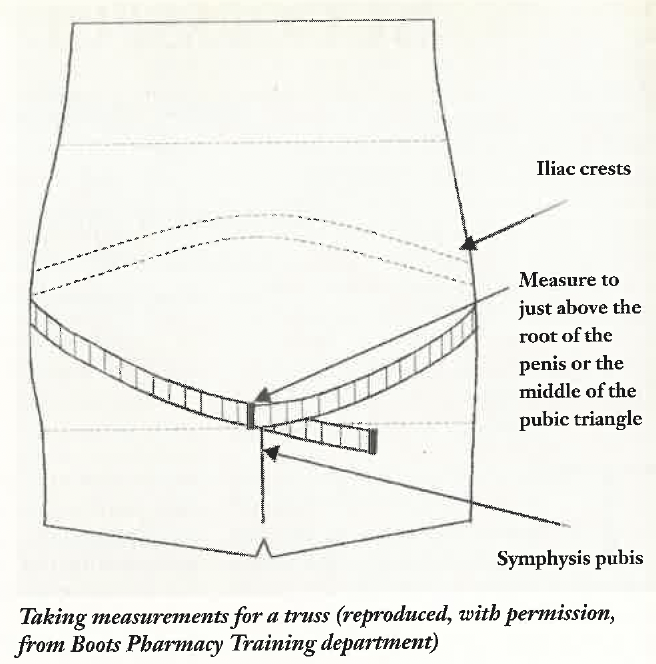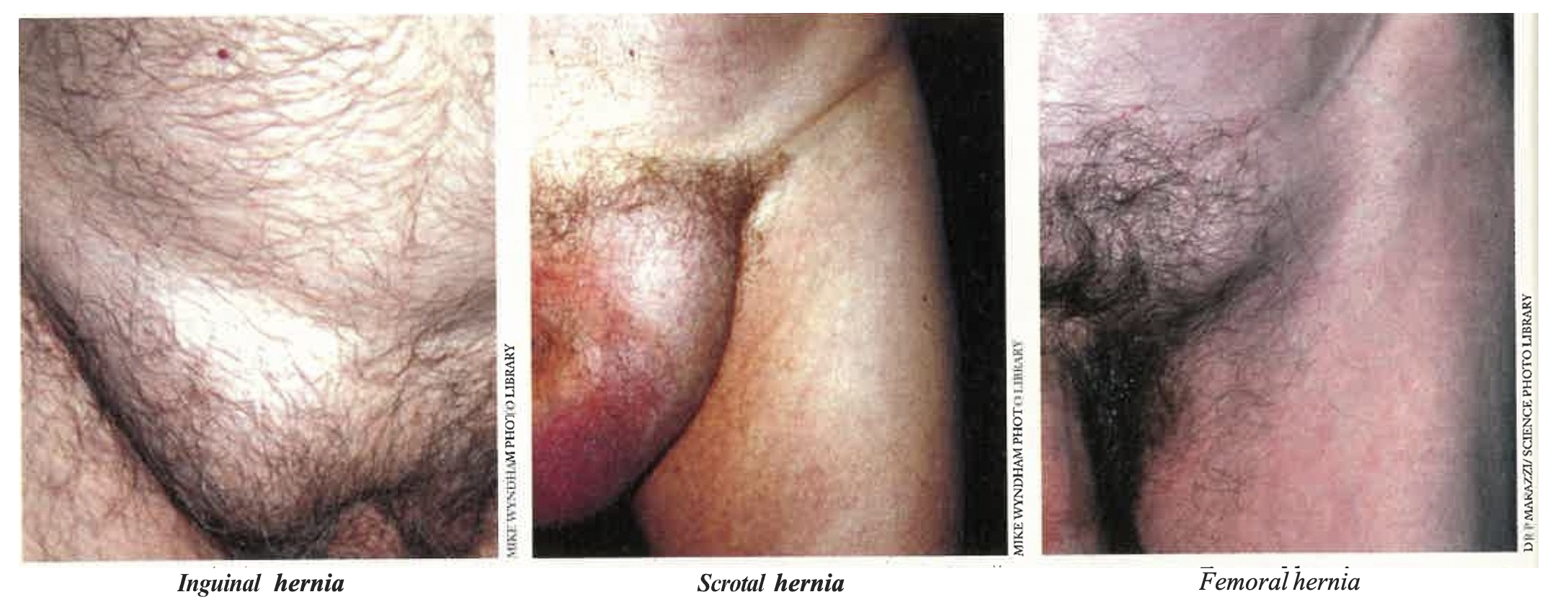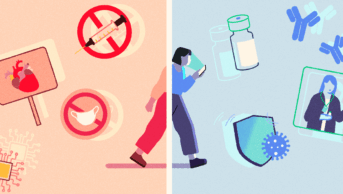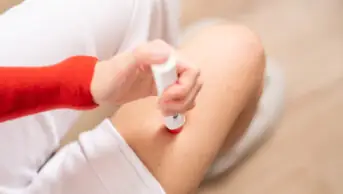This article provides an overview of truss fitting. It is not designed to take the place of practical experience. Ideally, truss fitting should be learned by watching an experienced fitter. Pharmacists might like to consider ways that they could change their practice once they have read the article.
Hernias
A hernia is defined as the protrusion of an organ through the abdominal wall. This is caused by a weakening of abdominal wall muscles and can occur following lifting, coughing or straining. People who are inactive or obese are particularly prone to hernias.
Hernias are categorised as inguinal, scrotal, femoral or umbilical.
Inguinal and scrotal hernias
Inguinal hernias are the most common type of hernia in men but are rare in women. This type of hernia involves the inguinal canal. In men, the spermatic cord passes to the testes through the inguinal canal and, in women, the inguinal canal contains ligaments of the uterus.
An inguinal hernia can occur on either side of the abdomen and can be direct or indirect. Direct inguinal hernias occur at the site where the inguinal canal leaves the abdomen, whereas indirect inguinal hernias occur when the hernia pushes down and splits the inguinal canal.
In some cases, an inguinal hernia can pass into the scrotum, when it becomes known as a scrotal hernia.
Femoral hernias
Femoral hernias are seen much less frequently than inguinal hernias and are more common in women than men. They occur where the femoral blood vessels leave the abdomen at the top of the leg.
Umbilical hernia
An umbilical hernia is a protrusion through the umbilicus. This type of hernia usually occurs in babies but can occasionally occur in adults; mostly in pregnant women or people who are overweight.
Treatment of hernias
The majority of hernias are corrected surgically by repairing the hole in the abdominal wall. The use of trusses is reserved for two situations: patients who, for some reason, cannot have surgery and patients waiting for surgery.
A truss is used to hold a hernia in its correct place in the abdomen. Therefore, they can only be used in patients who have a reducible hernia (i.e. it must be possible to return the hernia to its normal position in the abdominal cavity).
To test whether or not a hernia can be reduced, the patient should lie down. The hernia might naturally fall back into position or it might have to be reduced either by applying gentle pressure to the hernia with the hands or by raising the patient’s leg and bending the knee into the body. If a hernia cannot be reduced, the patient should be referred to their general practitioner. A hernia should not be forced back into the abdominal cavity nor should a truss be fitted over a non-reduced hernia.
Trusses
Fitting a truss is part of a pharmacy’s National Health Service contract and must be carried out when a prescription for a truss is present ed. Pharmacists cannot refuse to fit a truss although a member of staff other than the pharmacist can be trained to do the fitting.
A truss must be fitted against the skin, and not over clothes. Therefore, a private room in the pharmacy should be used or the patient should be visited at home. If the patient is of the opposite sex to the truss fitter, it is a sensible precaution to be accompanied by a member of staff of the same sex as the patient.
Patient counselling
- Hernias must be reduced before a truss is worn. A truss should be worn all day and be put on before rising in the morning. Trusses are usually removed at night but if a patient has a bad cough, a truss might have to be worn in bed. Elastic band trusses are more comfortable to wear in bed than spring trusses.
- Trusses should be worn next to the skin. In order to prevent soreness, the skin should be kept clean and a dusting powder applied to the area before the truss is put into position. If the truss does not stay in position, the patient should be advised to consult the pharmacy.
- If pain is experienced while wearing a truss the patient should contact their general practitioner immediately. This is because of the danger that the blood supply to the hernia may have been cut off (often referred to as a strangulated hernia). Pain in the hernia might also be caused by a number of other problems so should always be assessed by a doctor.
- A truss should be cleaned by wiping it with a damp cloth; it should not be immersed in water. Trusses need to be renewed approximately every 12 months.It is important to emphasise the need to take the truss off and clean the skin underneath.
Types of truss
A truss consists of a pad that keeps the her nia in place and a belt to keep the pad in place. There are different types of pad and belt, according to the type of hernia.
The type of pad needed is determined by the location of the hernia. There are different types of pad for inguinal,scrotal, femoral and umbilical hernias. If it is unclear whether or not an inguinal hernia has descended (ie, whether or not it has become a scrotal her nia), a scrotal pad should be used.
Two types of belt are currently in use and the prescription should specify which type is required.
A spring truss consists of a rigid belt with a metal spring whereas an elastic band truss is an elasticated, flexible belt. Since hernias can occur on either side of the abdomen, and two can occur at once, a belt can·be left, right or double.
Elastic band trusses tend to be used more commonly than spring trusses. Some people who started wearing trusses many years ago when elastic band trusses were not available still wear springy trusses today.
The drug tariff
Inguinal, femoral, scrotal and double inguinal/scrotal spring trusses can be ordered on an NHS prescription. However, only inguinal, scrotal and umbilical elastic band trusses are permitted. Elastic band trusses are not allowed for femoral hernias.
The National Pharmaceutical Association Guide to the Drug Tariff gives further information about truss items that are allowed to be ordered on an NHS prescription.
Prescriptions should be endorsed with the position of the hernia, the type of belt needed, whether the truss is single or double and the type of pad used (the size can be mentioned). In addition, prescriptions for trusses should be endorsed “measured and fitted” for a professional fee to be paid.
Truss measuring
It is essential to measure a patient for a truss correctly. When being measured, the patient should be undressed and standing up. The hernia itself is not measured.
A measurement should be taken around the body from the iliac crests to the symphysis . pubis. In other words, from the top of the hip bones to the junction of the pubic bones. The symphysis pubis is found at the top of the root of the penis in men and in the middle of the pubic triangle in women.
This measurement is all that is needed for elastic band trusses. However, spring truss es need to be measured more precisely. This is because there is some room for adjustment with elastic band trusses but not with spring trusses (although it is still essential to take accurate measurements for both types).
For umbilical hernias, a measurement should be taken around the body at the exact position of the hernia.

Truss fitting
When fitting a truss, the patient should be undressed and lying down. The hernia should be reduced and the truss fitted against the skin. It is important to check that the patient can reduce the hernia themselves because they will have to reduce it at home each morning before putting the truss on.
Elastic band trusses
Elastic band trusses should be put around the waist with the pad placed in position and tightened to fit. The patient should then be asked to stand up and the understraps of the belt should be fixed in position. The understraps run from the front of the belt, under the testes and up onto each side of the belt. Therefore, the hernia is held in place by pressure on top of the pad from the main belt and then from underneath by the understraps.
Once the truss is in position, it should be tested. To do this, the patient should be asked to cough and the hernia checked to see that it remains in position underneath the pad.
Spring trusses
Spring trusses should be pulled up into position in the same way that underwear would be pulled up. Care must be taken that the pad is placed in the correct position. The patient should be asked to stand and the understraps of the belt should be adjusted to give firm support.
Trusses for umbilical hernias differ in that they do not have understraps.
Once the truss is in position, it should be tested. To do this, the patient should be asked to cough and the hernia checked to see that it remains in position underneath the pad.
Problems with trusses
If a truss is not fitted properly, it might not provide enough support and consequently be uncomfortable. Discomfort can also be caused by the understraps not being in the correct place or not being tightened sufficiently so that they ride up. The pad can also cause discomfort if it is not the correct size.
Over time, the elastic in elastic band trusses may “give” and so this type of truss might need to be tightened.



